
| WWT Shows | CLICK TO: Join and Support Internet Horology Club 185™ | IHC185™ Forums |

|
• Check Out Our... • • TWO Book Offer! • |
Welcome Aboard IHC185™  Internet Horology Club 185
Internet Horology Club 185  IHC185™ Discussion Site Main Page
IHC185™ Discussion Site Main Page  Interesting Horologically Based Stories
Interesting Horologically Based Stories  Larry Buchan's ..."Tales from the Rails"
Larry Buchan's ..."Tales from the Rails"  Spring of 1975
Spring of 1975
 Internet Horology Club 185
Internet Horology Club 185  IHC185™ Discussion Site Main Page
IHC185™ Discussion Site Main Page  Interesting Horologically Based Stories
Interesting Horologically Based Stories  Larry Buchan's ..."Tales from the Rails"
Larry Buchan's ..."Tales from the Rails"  Spring of 1975
Spring of 1975Go  | New Topic  | Find-Or-Search  | Notify  | Tools  | Reply to Post  |  |
| Railway Historian IHC Life Member Site Moderator |
On Thursday April 10th 1975 I was called for our regular time of 08:15 on the Zone 3 Way freight, this was my last week working this assignment with the regular crew Conductor Fred Foulston, Tail end Brakeman Jim McKinnon, and Locomotive Engineer Stan McPhedran. I had been working this assignment since February 1974 the first three months as tail end Brakeman, and the rest of the time on the head end working with the Locomotive Engineer. My duties as head end Brakeman required me to report To the General Yard Office at Alyth pickup my portable radio and go to the Alyth Diesel shop to take our power (locomotive's) I would do a radio test to make sure we were communicating okay. And then go to the head end of our train in Victor yard tie on to the train release the hand brakes and work my way back to the caboose where I would find the tail end Brakeman Jim McKinnon. Jim was there attending to his duties which included putting out the tail end markers on our caboose CP 434169, and making a pot of coffee, of which I poured a cup of. After visiting with him I would work my way back to the head end of our train and wait for the Conductor to bring us our train orders and work lists. Fred was there with our orders and lists which I read out, we were cleared as the Work Extra 8627 from Shepard to Wimborne, Wimborne to East Coulee,East Coulee to Shepard, and with orders for a side trip from Irricana to Tudor. I went into the front nose of the locomotive and found two white flags among our other supplies these I put up in the flag holders on the front of the locomotive. These along with the white classification lights showed that we were running as work extra, the markers on the caboose would indicate we were a train. After completing our brake test we left Alyth and proceeded eastward on the CPR's Brooks subdivision to Shepard where we left the main track at the junction switch for the Strathmore subdivision from here on we literally owned the railway as no other trains were authorized on the tracks we were about to travel on. A way freight is an assignment that does all the work along the road it travels it stops at all stations and does the necessary switching as required. The subdivisions we were about to travel on to namely the Strathmore, Langdon, Irricana, and Acme were prairie branch lines and their main source of revenue was from grain , along with sulphur from Wimborne and coal from East Coulee. Our train consisted of empty grain boxcars, tank cars for sulfur loading, and boxcars for coal loading. My job on the head end was to get off at each station and cut off the number of empties that were required for each grain elevator in the back track and spot them on the spouts for loading. The towns we stopped at along the way included Shepard, Langdon, Dalroy, Keoma, Irricana, Nightingale, and Tudor. We had not made a side trip to Tudor were quite a while and as you can see in the picture way ran into quite a few snow drifts along the way. Stan took this picture when we arrived at Tudor we had to get out of back door of the locomotive cab so I could shovel away the snow from the front in order to have access. Many things things have changed since this photograph was taken Fred, Stan, and Jim have all passed away, I retired on a medical pension in 2001, the branch lines have all been torn up, and the locomotive has been rebuilt into a yard engine. Buchaneer IHC Charter Member 28 IHC Life Member (L7) | ||
|
| IHC President Life Member |
Larry "Buchaneer" Buchan at Tudor April 10, 1975... | |||
|
| IHC President Life Member |
Canadian Pacific Railways Caboose, taken at Alyth General Yard Office... | |||
|
I ride the via rail in Canada sometimes and took some long trips about 20 years ago.I really enjoyed it then.It was very comfortable with extras like some one who would polish our shoes and return them in the morning. Any ways i really like the big steam locomotives and wish i was around to have seen them instead of looking at pictures or seeing them at the museum. I really enjoy these old pictures and the train stories. I hope there are many more. Kevin West | ||||
|
| Administrative Assistant |
Kevin, What Larry is doing by providing his recollections means generations to come will be able to enjoy RR watch and clock collecting to a much greater extent. The support and encouragement people like you are providing Larry has become his inspiration. His unique stories are always special, and they spark storytelling in others. Welcome to Chapter 185 Kevin, thank you for joining us! Dr. Deborah L. Irvine Chapter 185 Administrative Secretary Chapter 185 Membership Coordinator NAWCC Member 157487 IHC Member 164 IHC Life Member (L4) | |||
|
| Railway Historian IHC Life Member Site Moderator |
CPR Caboose 437169 This was quite an old caboose built by the CPR around 1910, during the second world war the CPR placed plywood sheeting on the exterior of these Van's, underneath is V-joint hardwood, to help better insulate them. It did not work too well as I can remember waking up to some pretty frosty mornings in the winter after the coal fire in the caboose stove had died out during the evening. By the mid 1970s when I took this photograph these caboose's were assigned to branch lines service and their days were numbered, considering they had over 65 years service by this time the company definitely got their money out of them. The yellow painted handrails were for boarding and getting off on the move, and as you can see the boxcars on train were equipped with ladders, grabirons, and stirrups for riding on the cars when switching in the yard or on the road. You could climb up the ladders on the sides of the boxcars to get at the hand brake, and there was a running board as you can see on the end of the caboose that you could walk from car to car to secure the hand brakes. When boarding cars in motion anywhere on the train it was good safe practice to get on the leading ladder of the car depending on the direction of travel, the idea of this was that if you missed the ladder or stirrup and were thrown off the train you'd bounce off the side of boxcar rather than in between the cars where you could be run over by the wheels. The only exception would be boarding the caboose where the end platform was always used, the curved yellow grabirons you can see on the side at each end of the caboose was for boarding at high speed. In some instances, such as a situation where you had to board the train on a heavy grade where if you slowed down the train would stall, you would grab the curved hand rail with both arms and gravity would do the rest throwing your feet onto the rear step of the caboose. The first time I tried this I was a little skeptical, this was at Langdon, Alberta and we had stopped to pick up some grain our train was quite heavy with about 80 cars the conductor and I were about the middle of the train and the engineer had to really open up the throttle otherwise if the train stalled we would have to take half of the train 7 miles over to the next siding at Bennett and come back for the rest of the train which would take hours. Anyways the old conductor told me this trick of the trade, so I took him by his word, by the time the caboose was approaching the train must have been going between 15 and 20 miles per hour, I thought to myself this is it it's now or never I grabbed the curved grab iron and hung on with all my strength, I felt like every vertebrate of my spine stretched out 1 in. but sure enough my feet landed safely on the end step of the caboose and away we went. You can see on the left-hand side of the end platform the horizontal wheel for the hand brake these were called "Stemwinders" they operated much like the winding mechanism of a pocket watch. The brake wheel was spoked with a square hole in the middle that engaged a square steel shaft that ran down to a bracket that was mounted underneath the rear platform or endsill of the caboose, here a chain wrapped around the square shaft and was connected by brake rigging to the cast-iron brake shoes on each set of wheels. Underneath the hand brake wheel by the end railing was a toothed Crown wheel on the square shaft and a dog casting that operated much like a click spring of a pocket watch, it had little cast-iron counterweight that kept the dog engaged with the teeth on the Crown wheel and by turning the hand brake wheel the brake shoes would engage the wheels to apply the brake harder a hardwood brake club that looked much like an axe handle was placed through the spokes of the hand brake wheel and against the square shaft for leverage. A lot of the older rolling stock boxcars and particularly flat cars were equipped with these type of hand brakes, they were very dangerous to operate as when the dog that engaged the toothed wheel was disengaged when using a brake club they would kickback and many brakemen were thrown off of cars and were either killed or received serious injuries from this practice. This changed around the time of World War II when a locomotive fireman invented the Ajax hand brake which has a vertically mounted hand brake wheel that is much safer to operate. Another feature on this caboose is the wooden board nailed to the Cupola with the 5-gallon pail sitting on top of it, this was a marker used to find the caboose in the train yard, trains were made up by switchmen in large terminals and when the tail end crew, conductor and rear brakeman, went to work they would have to find the caboose in a sea of railroad cars where it could be positioned anywhere in tracks that were over a mile long by climbing up the ladder of boxcar a crew member could look around the yard and see the 5-gallon pail sticking up above the other cars in the yard and find his way to the caboose. At the time the caboose's were used in freight service and assigned to crews these markers were like a license plate and in caboose tracks at home and away from home terminals there could be dozens of cabooses that all looked alike with these markers it made it easy for the switchmen and crews to find the right one for the train. Buchaneer IHC Charter Member 28 IHC Life Member (L7) | |||
|
Great post as always Larry -- Thank you! Stu | ||||
|
Larry, Thanks for sharing this story with us. The only thing that is missing is sounds of the trainyard; the screeching of the wheels on the tracks, the whistles, and the loud "thump" when the cars are coupled. Please keep these stories coming. Phil Dellinger NAWCC# 157070 IHC Life Member (L12) Proud IHC Member# 140 | ||||
|
| IHC Member 1110 |
Hi Larry, was that locomotive a GP-9?That's what it looks like.I used to watch The Central Vermont trains thru our area in Connecticut USA.They ran them long end forward.Thanks again, Ted. | |||
|
Larry, another great RR story! You have the knack of remembering the smallest details from years ago. It makes your stories that much more interesting. | ||||
|
| Railway Historian IHC Life Member Site Moderator |
Hello Ted: Here is the information on the locomotive; Road Number CPR 8627, Class DRS-17c ( Diesel Road Switcher 17 HP class-C) EMD GP9 1750 hp, outshoped May 10, 1956. All the CPR geeps were built to run with the short hatch forward, some of the other first-generation diesel locomotives on the CPR built by the Montréal Locomotive Works, and the Canadian Locomotive Company did run with the long engine compartment leading. I believe this practice went back to the steam era, where they thought there was more protection having the engine in front of you, but it sure cut down on the forward visibility. The CPR converted all these locomotives to short hatch forward around 1965 when I worked at their locomotive repair shop at Ogden in Calgary Alberta. in the 1990s on the CPR GP's were taken out of freight service, and were subjected to a major overhaul at Ogden the forward hatch was cut down, and Windows were installed across the front like the bigger General Motors SD-40's for better visibility, the electronics and prime movers were all rebuilt and the locomotives went into yard service across the CPR system. The Central Vermont was a subsidiary of the Canadian National Railways, as was the Grand Trunk Western. Larry | |||
|
| IHC Member 1335 |
Great posts Larry. My brother Donald "TURBO" Brunton was a CNR engineer ,working in Sioux Lookout Ontario,Winnipeg,Manitoba, and Vancouver British Columbia and another dozen of my family were brakemen, firemen, conductors,car-men, signal maintainers etc. mainly in Sioux Lookout. I remember taking the steam train halfway cross country , and watching the coal smoke coming down between the cars as we navigate around a sweeping turn,I loved the smell of it.I took the diesel a few times from London Ontario to Winnipeg and to Sioux Lookout and just loved rail travel, I found it so relaxing. I'd like to see a picture of your CPR RRR clock,and as requested ,I posted you pictures of mine ,which Lindell drooled over,ah,what a joy to savor the real tangible rewarding percs of ownership!!! | |||
|
| Railway Historian IHC Life Member Site Moderator |
Hello Tom: It sounds like you come from a large railway family, and that you witnessed the end of the steam era. I've started a new thread to post the picture of my Seth Thomas #17 to keep it separate from the Canadian Private Labels thread, I will post some more pictures of my CPR and CNR station clocks if you're interested. If you don't mind could you please repost your Grand Trunk Railway clock and ORT GTR go withs on this new thread in order to keep everything together. Larry | |||
|
| IHC Member 1335 |
Done as you requested sir and I'd love to see your clocks !!! | |||
|
| IHC Member 1110 |
Thanks for the info on that loco, Larry! I love the sound of those turbocharged EMD's.I'm a diesel mechanic (truck/ heavy const. equip.}, so I have fuel oil for blood!.....Ted. | |||
|
| IHC Member 1110 |
Larry, I forgot to mention that I often saw Central vermont trains running with Grand Trunk or D.W. & P. locomotives as well as their own Geeps pulling them.Lots of Canadian cars in them.They were going to New London, end of the line....Also, I don't know if you already know this, but on You Tube, there's some video of the Alyth yard where you worked out of.Really interesting.Thanks very much! Ted. | |||
|
| IHC Member 163 |
Larry, are you compiling your stories for a book? That would be one GREAT 'read' my friend, and something I hope you are seriously considering doing. You have a knack for 'telling the tale' in a clear and concise manner. The photos you've provided in other threads (as well as the ones Lindell placed in this one) makes one feel like they're right there with you as you tell the story too. HIGH regards! Mark | |||
|
| Railway Historian IHC Life Member Site Moderator |
Hello Ted: The D.W. & P. Was another Canadian National Railways subsidiary called the Duluth Winnipeg and Pacific Railway which ran through northern Minnesota and had connections to Canada at Winnipeg Manitoba, and Port Arthur, Ontario. I checked out some of the videos on YouTube of the CPR's Alyth yard, it brought back many memories, the newest one made two months ago shows 2 General Motors SD-40-2's moving backwards and forwards on the Hump assignment, when you watch it you will notice when the locomotives change direction you can hear the locomotive bell. The reason for this is that these locomotives are controled by Belt Pak technology, there is no locomotive engineer running this train it is all done remotely from the control tower, or by a crew member on the ground who wears a battery operated remote control strapped to his chest. Mark: I have been compiling my stories of my working career on my website railwayearth.com under The Boxcar blog. Larry | |||
|
| IHC Member 163 |
Heading there now, Larry! Thanks! HIGH regard! Mark | |||
|
| IHC Member 1110 |
Thanks again Larry, I had no idea that you could do switching with an unmanned locomotive!Do you have any pictures of the diesel shops there?Looks like they have a pretty big operation going on there.Take care, Ted | |||
|
| Railway Historian IHC Life Member Site Moderator |
Hello Ted: Here is a photograph I took of the East end of the CPR Alyth diesel repair shops, back in 1979. There are 10 pits starting with Pit #1 on the left-hand side, all the pits ran through the building except for five and six that were stubs, and were used for working on wheel sets. The diesel locomotives sitting outside the building are waiting for their turn to go through the facility for inspection and minor repairs before being sent outside of the west end of the building where they will be dispatched for their next road trip. The graveled pathway visible between the two switch stands, the Local Chairman of Division 355 B of LE got the company to do this. In the foreground were built at the locomotive engineers request, so they didn't get their feet dirty stepping in pools of Crater grease, that was used to lubricate the traction motors. The other locomotives were waiting outside, after they had been the fueld, sanded, and watered. The racks were incoming power was left on the completion of a road trip. I will post some more pictures and facts later. Larry 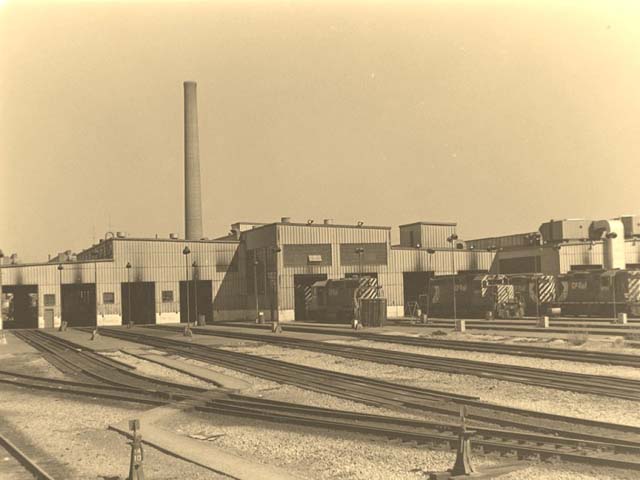 | |||
|
| IHC Member 1110 |
Hi , Larry.Thank you again.Looks like a busy shop.Must have been hard to keep anything like heat in there in the winter.There must be several turntables there near the shop area.I'm getting a great education from all this.Thank you, sir!...Ted | |||
|
| Railway Historian IHC Life Member Site Moderator |
Hello Ted: Here is an aerial photograph of the Alyth Diesel Shops taken in 1980's in the foreground the silver tanks filled with diesel fuel. On top of the photo is the Black Trail overpass To the right side of the picture beside the smokestack from the powerhouse is the turntable and the remains of a 36 stall roundhouse from the steam era and above it are the remains of the Calgary Stock Yards and the Burns Packing Plant. 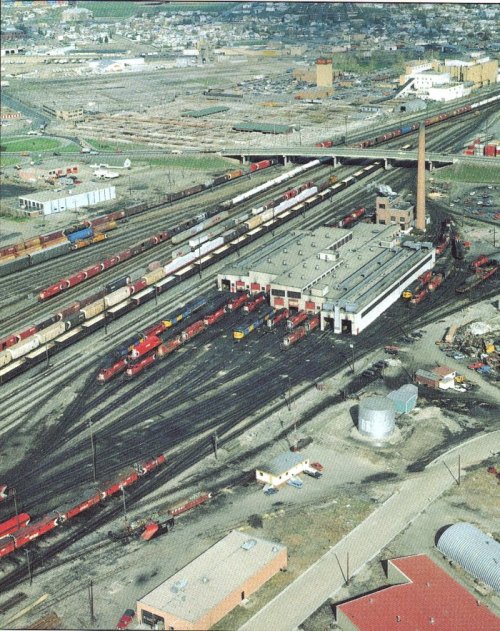 | |||
|
| Railway Historian IHC Life Member Site Moderator |
Here is a photo showing the fuel racks, the top view shows a locomotive being fueled, the large yellow structure is full of sand for the locomotives, and it traveled on rails up and down the fuel rack to service groups of locomotives sitting stationary while they were being refueled as shown in the second view. A funny story the CPR spent a lot of money in the late 1980s modernizing this feeling facility. One morning in the summer I had come to work on one of the day road switchers assigned around Calgary leaving at 07:00 in the morning, on my return that evening about 20:00 I went to put my locomotive consist on the fuel rack, and much to my surprise the yellow sanding tower and its support framework and traveling rails were laying flat across the fuel tracks. During the day shift they were moving this machine when a strong wind came up and blew it off the ends of its rails. The CPR then brought out cutting torches and cut it up into small pieces and loaded them into scrap cars. This must have cost them a lot of money, but on the railway you can't hold up production, and a blocked fueling facility would create a big bottleneck in the system. The bottom view shows a Hostler fueling a locomotive, the tracks in this facility were all covered with steel grating, and any fuel that spilled was recaptured in holding tanks underground. Larry 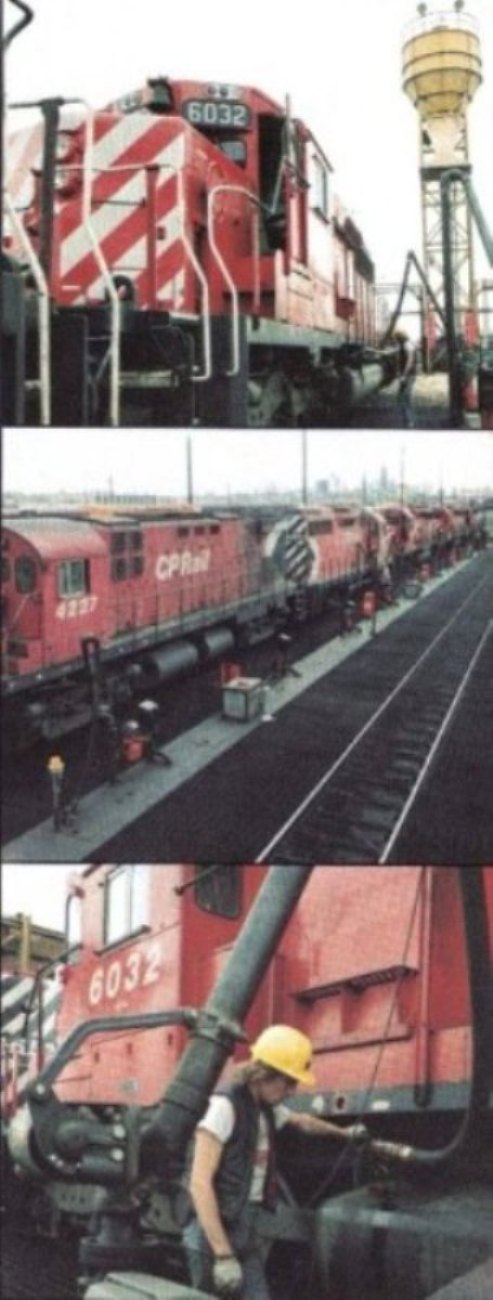 | |||
|
| Railway Historian IHC Life Member Site Moderator |
Here is a photo I took from the Blackfoot Trail Overpass in the spring of 1975, it shows the West End of the Alyth Diesel Shops and the powerhouse, the locomotives sitting outside the doors, and the ones alongside the building on the right side of the photo are ready to go on outbound trains, on the left-hand side just visible is a CPR rail diesel car being turned on the wye and being readied for its next passenger assignment from Calgary to Edmonton (Alberta's provincial capital city) 190 miles north. The Tank cars beside the powerhouse containing commodities that need steam heat to liquefy them (molasses from January?), they will be connected to steam from the powerhouse until such time they are taken to their customers spur for unloading. Larry 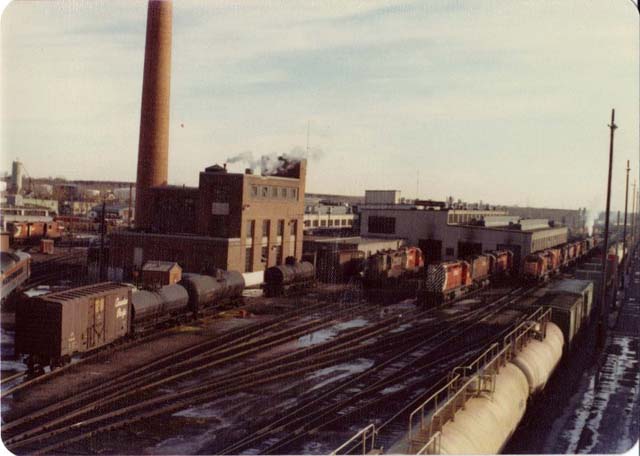 | |||
|
| IHC Member 1110 |
This just keeps getting better,Larry!Were they running their whole operation with that power plant, or do they get some of their power from "the grid".I wonder what they had for generators in there.I can only imagine what their fuel bills must have been like.I'm sure that today they must put a big fuel surcharge on every load delivered.Thanks again, Ted. | |||
|
| Railway Historian IHC Life Member Site Moderator |
Hello Ted: This powerhouse like most in Alberta were originally coal-fired, in the late 1940s huge finds of natural gas fields in northern Alberta, made this fuel a cheap alternative to burning coal and most powerhouses in Alberta were converted to natural gas firing. The powerhouse at Alyth was originally used for the 36 stall roundhouse, and was adapted to the diesel shop, a few years ago the smokestack was torn down and a new modern package boiler was installed. The diesel shop itself is about to go through a big transformation. In the late 1990s CPR started buying General Electric 4400 hp alternating current locomotives, and all the maintenance was looked after my General Electric under the extended warranty these locomotives were provided with, so Alyth lost its status as a running repair shop, and became more or less a glorified filling station for fueling, sandiing, and watering these locomotives. Maintenance of the GE locomotives was done in Vancouver, British Columbia and down the east. But big plans are being made, the original diesel shop will probably be torn down, and a new structure will be built that will have 3 bays and will extend eastward to the fuel racks. Larry | |||
|
| Railway Historian IHC Life Member Site Moderator |
A new generation of yard switchers is appearing at last at Canadian Pacific, but in the form of modified first-generation road locomotives rather than new switcher purchases. ALCO and MLW S-2 and S-4 switchers are now very old (built between 1943 and 1953) and the newer MLW S-3, S-10, and S-11 switchers are not considered powerful enough for current switching assignments. Hence, all, totaling nearly 200 units, will be retired. To replace them, 5 Major Rd. switcher models of the first-generation diesel era will be called upon. To branch line unit models the RS-23 and the SW 1200 will take over yard assignments with only a few exceptions, and nearly all the GP7R/GP9R/GP9 family will be subject to extensive modifications to transform these units into yard switchers, the programme will create nearly 300 new yard locomotives, almost all in much higher horsepower blocks than previously available although many will be still used in Road service. CP Rail 1512 is the first locomotive converted under the new programme, shown here at Alyth Yard in July 1980 just emerged from Ogden Shops. Formerly GP9R 8510, it received the chopped nose, a new number board assembly above the windshield and foot boards on the pilot. Inside, the cab was modernized, the dynamic brake was removed (although the protruding grilles remain) and the electrical system updated and rewired. The horsepower rating remains at 1750. GM locomotives were chosen over MLW units for this part of the programme because the 2 cycle engine was considered more suited to numerous and rapid changes in engine speed than the 4 cycle engine. 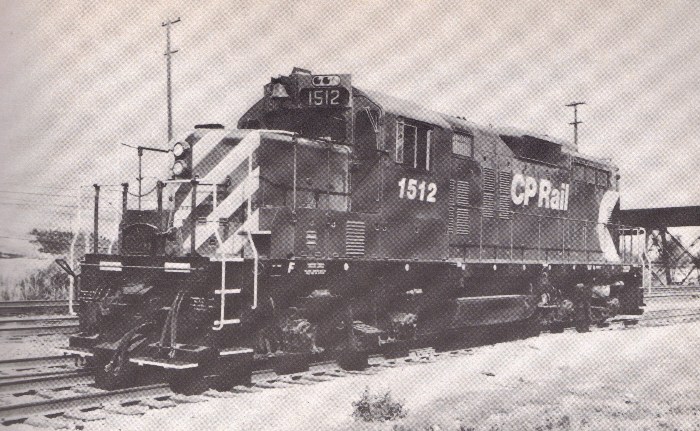 | |||
|
| IHC Member 1110 |
Thanks Larry for the great info.Even though this conversion program will cost a fortune, it's probably still a lot cheaper than buying that many new units.I notice on the CPR videos on YouTube ,that there are a lot of GE's in use now.How long can a road locomotive go between engine overhauls?With good maintenance, I would think quite a long time! Thanks again very much...Ted. | |||
|
| Railway Historian IHC Life Member Site Moderator |
Ted:: In the steam locomotive age the distance they can travel was 125 miles. When the first generation of diesel locomotives, they were quite surprised that the locomotives could run from Winnipeg to Alberta a distance of 600 miles with no other maintenance needed. The fuel tanks on a SD-40-2 held 3000 Imperial Gallons of diesel fuel. Larry | |||
|
| Powered by Social Strata |
| Your request is being processed... |
|
©2002-2025 Internet Horology Club 185™ - Lindell V. Riddle President - All Rights Reserved Worldwide

